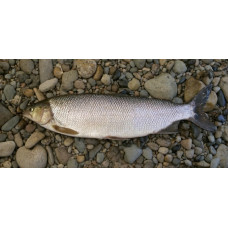Latin name
Coregonus nasus
Identification
The Broad Whitefish has a broad, compressed body. Its nose is thick and humped, protruding behind the lower jaw, and its mouth is small. It is characterized by short gill blades that are less than one-fifth the width of the interorbital space and a rounded to flat head profile. Vertebrae: 60–65. These fish have large, dense scales.
Features of fish fins
Dorsal spines (total): 0; Dorsal soft rays (total): 10 - 13; Anal spines: 0; Anal soft rays: 11 - 14.
Like all whitefish, it has an adipose fin. Its adipose fin is rather large, and its pelvic fins have an axillary outgrowth.
Fish colouring
The sides of the broad whitefish are silver with a golden hue, and the back is dark.
Distribution
It is widespread in rivers and lakes in northern Russia (the European part, Siberia, and Kamchatka) and the northern provinces of Canada. It may also inhabit semi-preserved waters of Arctic Ocean bays.
Habitat
This polar freshwater pelagic species prefers brackish waters. They inhabit lowland rivers and lakes, but are most often found in streams.
Size
Males of this species have a maximum length of 71.0 cm and a total length of 46.0 cm. The maximum reported weight is 16.0 kg. The maximum reported age is 15 years.
Behavior
It is a migratory species. There are lake and estuarine anadromous forms. Adults begin their upstream migration in late July or August and reach the spawning grounds by October or November. They spawn in areas with fast currents and sandy or pebbly bottoms, often under ice. After spawning, the fish leave the site and migrate downstream to overwinter in the deeper areas of the lower river with the adult juveniles. In the spring, the alevins drift downstream from the spawning areas with the flood waters. They forage in the floodplain lakes and flats for the rest of the summer before moving into the river or reaching maturity.
Food and feeding habits
These fish mainly eat benthic invertebrates. They feed on insects, crustaceans, and mollusks.
Reproduction
Males reach maturity at 4-8 years of age, and females at 5-9 years of age. Spawning lasts five to seven days. They spawn in the fall, from October to November. They swim with their eggs in September, entering the river with eggs that are already quite developed. They mainly stay in the quiet waters of the lower river, where they release the eggs. Then, they return to the sea. The eggs are light yellow and large, reaching up to 4.0-4.2 mm in diameter.
Fishing
It is a valuable commercial fish. It is caught using spinning, fly fishing, or a float rod. Various insect larvae, insects, and artificial baits, as well as mollusk meat, are used as bait. Traditional fisheries use gillnets and floating nets to catch them.
Relationship with a person
Harmless. It is characterized by its excellent taste and small number of bones. Since it lives in cold water, it has a high fat content. It is widely used in aquaculture.
| Classification | |
| Phylum | Chordata |
| Class | Actinopterygii |
| Squad | Salmoniformes |
| Family | Salmonidae |
| Genus | C. nasus |
| Species | C. nasus |
| Features | |
| Conservation status | Least Concern |
| Habitat | Pelagic |
| Life span, years | 15 |
| Maximum body weight, kg | 16 |
| Maximum length, cm | 71 |
| Sailing speed, m/s | No information |
| Threat to people | Edible |
| Way of eating | Planktonophage |
Broad whitefish
Tags: broad whitefish

